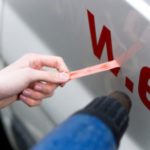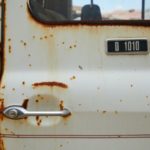Quick Navigation
With the rapid evolution of technology, the manufacturing industry adapts to new, better, and more affordable processes.
Chromium, also known as chrome, is one of the compounds used on car’s metals and plastics.

Its low density, high boiling point of the chrome, and low melting point properties are often applied on plastics like ABS (Acrylonitrile butadiene styrene). This is done to enhance heat resistance and reduce corrosion stress aesthetics.
Chrome plastic parts are found on emblems, grilles, door handles, trim strips, and wheel covers.
Home Remedies For Removing Chrome From Plastic Car Parts
Applying Bleach
Bleach is an everyday cleaning item, and you can easily use it for the effective removal of a chrome layer.
Depending on the size of your car’s grille or emblem, you can either soak pieces of cloth in bleach and use them to wipe or submerge the plastic.
For sizable plastic car parts or flat surfaces, soak pieces of clothes or towels in bleach, place them on the chrome surfaces for 18 hours, and then wipe them clean.
On the other hand, for the smaller car plastic parts, soak them in bleach for 24 hours, remove them and wash them clean.
Remember to maintain the timeframes to avoid plastic corrosion and wear gloves during the process.
Applying An Abrasive Mixture
Abrasives can only be used effectively on thin-layered car plastic items or parts since they are only rough enough to cover surfaces with little thickness.
For instance, thin plastic grilles and emblems can be stripped using this method.
Furthermore, the thin chrome strips usually found along the car’s sides can be removed using this method.
It also works best when applying to weak and thin chrome plating or a chrome plastic plating painted with “fake” chrome material.
To make the abrasive mixture:
- Use some baking soda and water.
- Mix the two well to achieve a paste-like consistency, then apply it to the chrome parts.
- Scrub lightly using a cloth for less than 5 minutes or until the chrome layer fades off.
- Keep in mind to have a pair of gloves on and not scrub for long to maintain the plastic.
Using Oven Cleaning Detergent
Can one use oven cleaning soap for this? Yes.
Oven cleaners have exemplary degreasing properties, effectively removing chrome layers even on plastics.
Simply put, apply the soap on the chrome parts and let it sit for 10 to 15 minutes. After that, wash lightly and wipe with a clean cloth.
Ensure not to exceed the waiting time as the soap may corrode the plastic or change its color.
If the chrome is the original plated one and it’s peeling off on its own along the grille or bumper. Especially if it has not been layered over, you can use the oven cleaning detergent method easily.
The oven cleaning detergent is also applicable to your car’s dashboard.
You will need to avoid leaving the parts sitting in the detergent for a while, as it will tend to “darken” the underlying metals since some oven cleaning detergents have been found to do so.
Alternatively, you can use oven cleaning foam in place of the detergent, and you will be sure to achieve the same results.
Using Sandpaper
For a not-so-skilled person on machines, hand scrubbing using sandpaper also goes a long way in removing a chrome layer.
Gently scrub the surfaces or parts with chrome until the layer fades out.
Also, avoid using too much force as it might scratch the plastic parts and avoid inhaling the dust to prevent health complications.

Use Standard Brake Fluid
Using the standard car brake fluid is another remedy for removing chrome layers in your car’s plastic parts, whether in the bumper, grille, dashboard, or emblem.
Brake fluid has thinning properties like that of paint, which quickly loosens the layers of chrome on the plastic parts.
However, most people avoid this method as it takes longer to work and requires proper handling and disposal of the brake fluid.
Using Tools And Machines (professionally)
Depending on your level of expertise or the extent to which one would prefer their chrome parts removed, choosing the professional route is also an efficient and effective way of attaining results.
Although these methods typically remove chrome on metal, some do pretty well on plastic items and surfaces.
The following strategies may also require a little more monetary investment than the home remedies due to the nature of their procedures and the people involved.
Using A Sanding Machine
Having mentioned hand sanding, the professional way which requires a fast-rotating sanding machine is the better and faster alternative.
However, it is vital to note that only a professional should do this and if not, hiring one also goes well.
In addition, this method works best for flat plastic surfaces and parts that are pretty easy to work around using the machine, like your car’s plastic bumper and grille.
Nevertheless, hearing from a professional who would give further advice on ripping out the chromium.
Using An Abrasive Blaster Machine
As the name describes it, this tool essentially blasts off or rather sprays out the chrome layer of the part intended.
Usually, one would find the machine in auto garages, scraping off the plating on plastic and metal car surfaces such as the bumper and the plastic and metal grilles.
It is crucial to seek professional assistance or hire one when choosing this method.
The machine employs tiny sand grains or any other coarse substance to chafe the parts of the chromium layer to desired conditions.
This process also requires the careful practice of machine handling measures like having masks, gloves, and eye gear while working to avoid minor injuries.
Also, the machine needs a setting to prevent damage to the plastic surface underneath the chrome.
Applying Reverse Electroplating/Stripping Method
Usually, one of the methods used in electroplating is to apply chromium on plastic parts or surfaces.
Therefore, it is suitable and adequate to reverse the process to remove the same layer.
In this method, the plastic part(s) comprises an anode and a conductor. Then a cathode of any other material is put in place, and the process begins.
The entire procedure promises very effective results; however, other more straightforward methods like those mentioned above are ideal for areas where the process may not have been quite efficient.
Disclaimer
Avoid experimenting with chemical substances to remove the chrome layers on your vehicle’s plastic parts. Especially the grille, dashboard, and emblem.
Using chemicals such as hydrochloric acid and sodium chloride may work on metals effectively. Still, they may not be the best or safest methods for plastics.
Concentrated chemicals quickly melt up plastics and can be dangerous to work with. They are not suited for this purpose.
What Is The Best Method?
The methods listed above are best depending on your skills and the size of the part you intend to clean.
Note that the techniques that would need a professional to step in to ensure safety and expected results.
Whether it is the home remedy way or the use of tools, one must practice safety measures as instructed.
Have and always recommend wearing protective gear while working to ensure health and safety at all times.

James has been a car enthusiast since his childhood when he learned the differences between a ford and a chevy from his father. He loves to drive and restore old cars with a special drive for Italian marvels. Currently, he has a 1968 Alfa Romeo. He has studied aeronautics and civil aviation in his college and still gets smitten by Galant SS and Lancer GSR.
He is a New York-based product training director working with a giant automotive retailer. He loves to review and uncover the vehicles and their fascinating stories. He believes in keeping it legitimate with a keen passion for research on the latest technological upgrades in cars. While reading his articles or blogs, you can sense the extensive research and dedication backing the piece of text. He loves fried chicken, music, and spending quality time with his pet dog.






